
Skin Overview
Epidermis
Outer layer of skin that acts as a barrier between the body and the environment. Stratum corneum, uppermost layer, is made up of corneocytes (flat, dead skin cells) forming skin’s barrier. Basal layer, bottom layer, is where pigment is produced.
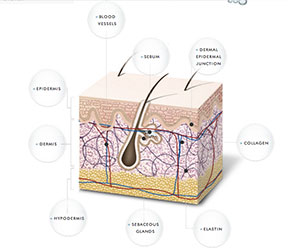
Dermis
The middle layer of the skin housing nerves, glands, essential proteins, enzymes, and blood cells, making it the skin’s “operations” center. Contains collagen and elastin which provide support and structure to skin.
Hypodermis
Lies below the epidermis and dermis and comprised mainly of fat, blood vessels, and nerves. This layer acts as a cushion that also insulates the body.
Sebaceous Glands
Located at the root of the hair follicles, these glands produce oil. This oil, or sebum, lubricates and waterproofs the skin and hair. Sebaceous glands are present everywhere except the palms and soles of the feet.
Elastin
Elastin is an essential protein that gives skin the ability to “bounce back” after stretching. The breakdown of elastin leads to sagging skin. Sun exposure and repeated facial expressions damage elastin.
Collagen
An essential protein that lends support to skin and gives it structure. It is one of the “building blocks” of skin’s foundation. The breakdown of collagen leads to fine lines and wrinkles. Sun exposure is the number-one cause of collagen damage.
Dermal Epidermal Junction
The DEJ connects the dermis and epidermis. The DEJ is home to a network of blood vessels that pass nutrients from the dermis to the epidermis. The DEJ thins with age, making the skin more prone to sagging.
Blood Vessels
A network of blood vessels is found in the dermis and subcutaneous layer. These vessels supply the skin with oxygen and nutrients. The blood vessels play a role in regulating body temperature.
Sebum
This oil-Overviewike substance is produced by the sebaceous glands. Sebum helps waterproof the skin. Sebum forms a film on skin that keeps water in and irritants out.
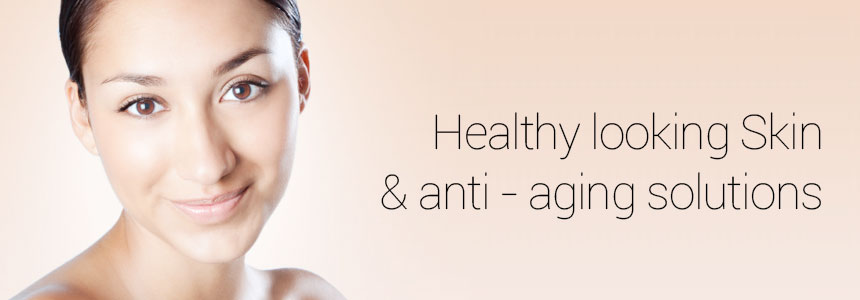
Skin Conditions - AGING
Epidermis
Surface cells shed more slowly, causing dullness.
Dermis
Skin’s metabolism slows down, affecting the production of integral cell types.
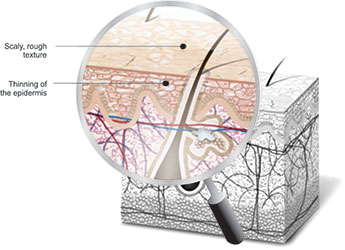
Sebaceous Glands
Oil production slows with age, leading to increased dryness.
Elastin
As elastin breaks down over time, skin loses its firmness and ability to “bounce back”.
Collagen
As collagen degrades and natural production shows, the skin’s underlying support structure weakens and wrinkling occurs.
Dermal Epidermal Junction
The DEJ thins with age, making the skin more prone to sagging.
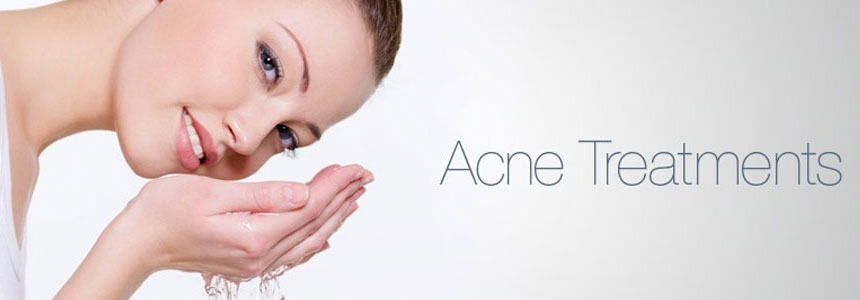
Skin Conditions - ACNE
Epidermis
Inefficient desquamation (cell shedding) leads to clogged pores.
Sebaceous Glands
Sebaceous glands are enlarged due to overproduction of oil.
Sebum
Follicles become clogged with dead cells, oil and debris.

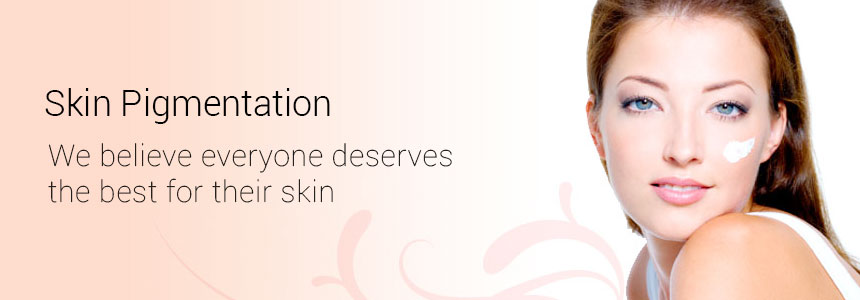
Skin Conditions - Hyperpigmentationhr>
Epidermis
Melanocytes overproduce melanin at the very bottom of the epidermis. At the top of the epidermis overproduction of melanin leads to dark spots on skin’s surface.
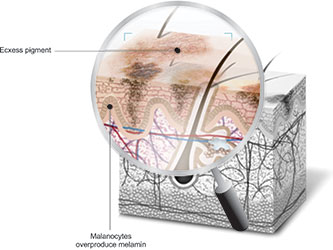
Sebum
Skin dehydration can cause overproduction of sebum as a result of oil being stripped from the skin.
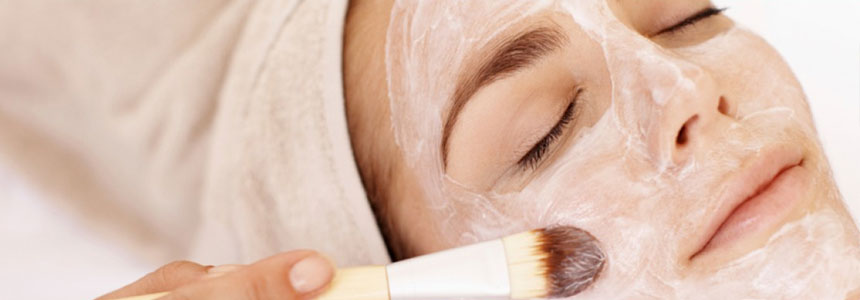
Skin Conditions - Dehydrated
Epidermis
Surface cells shed more slowly, causing dullness. The uppermost layer is thin and jagged due to lack of water.
Sebum
Skin dehydration can cause overproduction of sebum as a result of oil being stripped from the skin.


Hair Overview
Hair is a filament made mostly from protein (keratin) and protrudes out through epidermis. Thick, long hair on head is terminal and fine hairs throughout body are called velus hairs. Hair consists of two parts: Hair shaft and Hair root.
1. Hair shaft: It extends above the skin surface and consists of:
Cuticle: outermost layer formed from dead cells and gives the hair shaft strength.
Cortex: Fibrous middle layer of hair giving hair its weight and producing melanin.
Medulla: inner most layers consisting of circular cells.
2. Hair root: It is part of hair below the skins surface and consists of:
Follicles: Cell division and hair growth begins here.
Hair bulb: Cells of hair shaft are produced here.
Erector pili: makes hair stand straight up when scared or cold.
Sebaceous gland: Secretes sebum that lubricates hair.
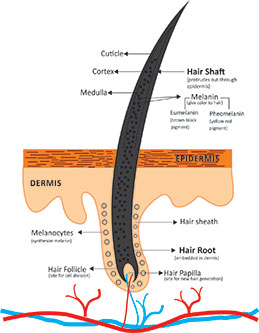
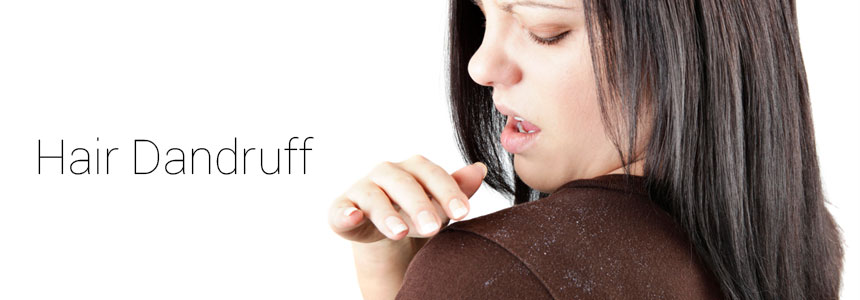
Hair Dandruff
Causes
Microbial Cause :
- Lipophilic yeast of genus Malassezia.
- During dandruff, the levels of Malassezia increase by 1.5 to 2 times its normal level.
- The lipophilic yeast digests sebaceous triglycerides, producing free fatty acids.
- The free fatty acids penetrate the stratum corneum and disrupt the skin barrier function, leading to range of symptoms.
I am text block. Click edit button to change this text. Lorem ipsum dolor sit amet, consectetur adipiscing elit. Ut elit tellus, luctus nec ullamcorper mattis, pulvinar dapibus leo.
Other causes :
- Family history, food allergies, excessive perspiration, use of alkaline soaps and yeast infection.
Seasonal dandruff :
- Cold, dry winters .
- Exposure to dust, UV light, harsh shampoos and hair dyes.
Skin types :
- Oily skin more prone to dandruff problems due to excessive sebum secretion which is a feed for fungus Malassezia furfur.
If hair are not shampooed regularly, oil and dead cells from the scalp can build up, causing dandruff.
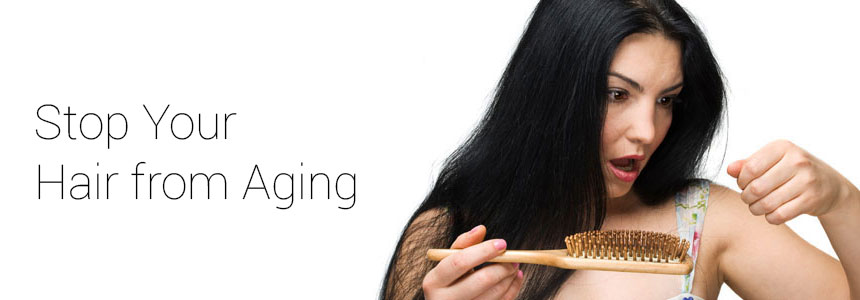
Hair Loss
Specific hair Issues
- Chronic Telogen Effluvium due to imbalanced hair cycle.
- Pattern hair loss due to genetic and hormonal influence.
- Other internal Conditions like iron or thyroid hormone deficiency.
- Injury to follicle caused by trauma, infection or other skin diseases.
- Various scalp conditions like atopic dermatitis, Seborrhoeic dermatitis.
Results In Hair loss due to
- Decreased growth of hair.
- Increased shedding of hair.
- Breakage of hair.
- Conversion of thick terminal hair to thin vellus hair.
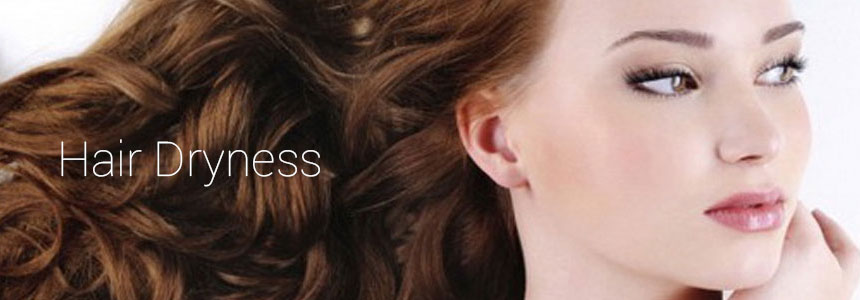
Hair Dryness
Dry Scalp
- Can be caused by inactive sebaceous gland, and aggravated by excessive shampooing or dry air, such as during winter or in a desert climate.
- Lack of sebum leads to hair that appears dull and dry.
- Should be treated with products that contain moisturizers and emollients.
- Products with sulphates should be avoided.
